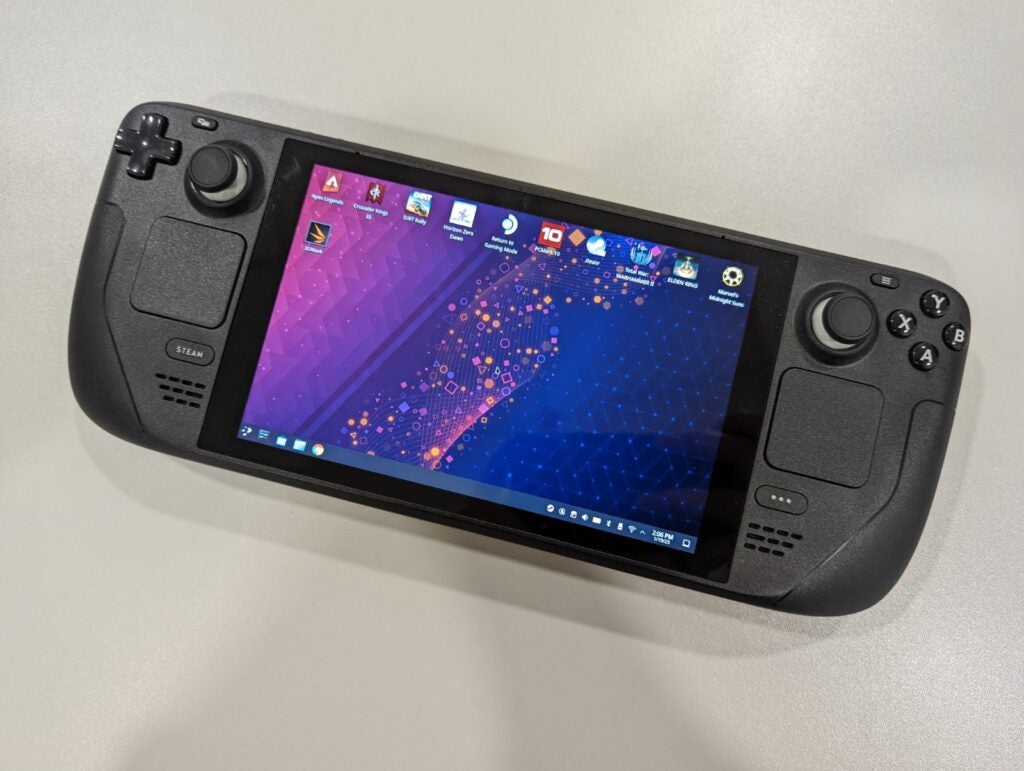In the last couple of years, there’s been a boom of interest in handheld PC systems, triggered by the launch of the Steam Deck in February 2022.
Lenovo is the latest company to jump aboard the bandwagon, launching the new Legion Go portable handheld. While it’s appealing to the same market as the Steam Deck, allowing you to take your PC games on the go, there are also numerous key differences.
So what’s the difference between the Lenovo Legion Go and the Steam Deck? We’ve broken down all of the key considerations below.
Steam Deck is more affordable
The Lenovo Legion Go is not a cheap device, with a starting price of £699 in the UK, and $799 in the USA. In comparison, the Steam Deck’s base price is just £349/$399, although upping the storage from 64GB to 512GB will increase the cost to £569/$649.
There are a few reasons why the Steam Deck is more affordable. It’s not quite as powerful as the Legion Go, and lacks a couple of its features. Valve (the maker of the Steam Deck) is also able to subsidise the cost of the portable since it should help to boost game sales on the Steam store.
Legion Go is more powerful
As we briefly touched upon above, the Legion Go is expected to be more powerful than the Steam Deck thanks to its AMD Z1 Extreme processor. This is the same chip found inside the Asus ROG Ally, which has already demonstrated a higher performance ceiling than the Steam Deck’s AMD APU.
That said, don’t expect a massive performance gulf between the two. When comparing the Steam Deck to the ROG Ally, we found there to be roughly a 10fps to 15fps performance advantage for the latter. That may ensure enough headroom for a smooth performance, but don’t expect it to handle modern games with max graphics settings and a smooth performance.
The Lenovo Legion Go also has a more advanced form of memory, using 16GB of LPDDR5X for a 7500MHz frequency. Meanwhile, the Steam Deck has the same capacity of 16GB, but an older form of LPDDR5 memory with a slower frequency of 5500MT/S.
The two devices also use different operating systems with the Legion Lenovo Go powered by Windows 11, and the Steam Deck using its own custom software based on Linux.

Legion Go has detachable controllers
The unique selling point of the Lenovo Legion Go is undoubtedly the capability to remove the two controllers that sit either side of the screen. This allows you to prop the Lenovo Legion GO up with its built-in stand to use in tabletop mode, similar to how you can use the Nintendo Switch.
For comparison, the Steam Deck’s controllers are built into the device, and are non-removable. If you only want to use your gaming system as a handheld, this shouldn’t be an issue, but there’s no doubt that the Legion Go offers more versatility.
Legion Go has a larger, higher resolution screen
Lenovo has decided to give the Legion Go a noticeably large screen, coming in at a whopping 8.8 inches. For comparison, the Steam Deck’s panel is only 7 inches, and so is 1.8 inches smaller which should make a big difference.
There’s a big difference in terms of screen resolution too. The Steam Deck is limited to a 800p display, while the Legion Go has a pixel-packed 1600p for twice as many pixels. This should result in sharper imagery, although it’s likely the Legion Go will only be powerful enough to play select games at this high resolution.
Lenovo even claims the Legion Go has a higher peak brightness than the Steam Deck. So judging by the specs alone, it looks as if Lenovo is offering a better display overall.

Steam Deck is 185g lighter
There’s a downside to Lenovo adding a bigger screen to the Legion Go, and that’s the extra weight it adds. With the controllers attached, the Legion Go weighs a hefty 854g.
That means the Steam Deck is 185g lighter, with the difference in weight being the equivalent of two apples. That could potentially be problematic, as the Steam Deck is hardly the most portable handheld around.
It’s worth noting that the weight of the Lenovo Legion Go drops down to 640g once you remove the controllers, although it’s unlikely you’ll be holding the device in your hands without the controllers.



